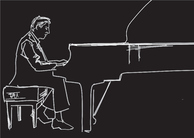From Earth Common Journal VOL. 4 NO. 1Edmonton Hiphop Kulture: Techniques of Self and Cultural SustainabilityIdentity DevelopmentThe terms identity and culture are abstract, frustrating and ultimately interesting because they are complex. The researchers theorize that techniques of self can lead to personal growth and in turn contribute to cultural sustainability. Self-expression and belonging are two techniques of personal transformation supported by Cipher5, which work on a deeper level to strengthen identity (Wang, 2010, p. 68). Cipher5 is a space where personal identity can be cultivated through the elements of Hip Hop. This section looks at three components: 1) how identity is shaped in the cultural practices of Hip Hop through stage names and or personas, 2) how Hip Hop practices are in particular productive for Aboriginal youth in Edmonton, and 3) how Hip Hop reflects on how Cipher5 participation contributed to the researchers’ development of self. Identity development is a common practice in Hiphop Kulture. Most of the artists in the circle go by a stage name or persona.4 In some cases, choosing a stage name may lead to the embodiment of a higher sense of self. For example, Shima, spoken word poet, freestyler and member of Cipher5 chose the name Dwennimmen, rooted in West African symbology, to strengthen her creative identity in a symbolic connection to her ethnic and cultural origins: Despite being born in Edmonton, I am continually asked to recount a version of my history, my cultural and ethnic origin. My family comes from Jamaica and I have always felt an estrangement from my roots . . . . I wanted to find my link to the continent that gave rise to black civilizations that have impacted the world with education, art, architecture and more. I wanted that link to transcend the physical and subjective distance between myself and the power and influence of African knowledge through the entire black diaspora. The Dwennimmen symbol represents the ram horns and the properties of strength, humility, learning and wisdom. I needed those four elements in my life at that time and still need them today. I began writing with the four virtues in mind, trying on the significance of this piece of ancient culture. I began living more honestly, feeling a deep sense of duty and connection to my own African-ness. I began freestyle rhyming and writing poetry with more clarity. Living with Dwennimmen in mind keeps me focused, spiritually nourished, connected and vocal. I give thanks to the ancient name. (Shima, personal communication, June 19, 2014) Shima made a conscious decision to develop a stronger identity; this technique of self is common in the Hiphop community and this process is often discussed at Cipher5. Identity development encourages hiphoppas to express themselves with confidence and clarity, and develops their creative abilities which contribute to the cultural sustainability of Edmonton Hiphop. Through participation in Cipher5, Edmonton youth may discover a cultural practice in which to identify. As it is, “many adults may . . . assume that the young are damaged somehow and in need of fixing”; this notion is “further exacerbated for Indigenous youth” (Donald & Krahn, 2014, p. 114). This is important to remember in Edmonton, where a significant and steadily growing Aboriginal population (Environics, 2010, p.17) poses an exceptional need for society to address “the ways in which Indian [Aboriginal] subjectivities have been legislated, marginalized, and pathologized” (Donald & Krahn, 2014, p. 114). It is perhaps no surprise then that Aboriginal youth make up the majority of the Cipher5 membership. Many members of the circle share stories of Hiphop as a saving force and as a way to re-connect with themselves. In a recent blog, Gyasi Ross explores his identification with hip-hop in the context of a childhood spent on the Blackfeet and Suquamish Reservation: The songs contained survival messages, just like our own powerful songs—codes for future generations . . . . In a world where Natives are often taught that our traditions are evil or primitive or unworthy, we understood breakdancing's threat and energy and celebration of dance. It fit into our world well. We didn't have to choose "either/or," we could do both—celebrate our Native culture, as well as relate to this other culture thousands of miles away. (Ross, 2014, July 1, para. 20-21) Ross’s testimonial suggests how Aboriginal youth in Edmonton may identify with contemporary artistic practices without compromising the essence of their cultural backgrounds. With Brass’s, Kirmayer’s and Valaskasis’ (2009) recognition that cultural identities are ever-changing, this blending of cultural practices is an example of “how the many strands of knowledge available today from diverse cultures of the world can be woven together in new patterns” (p. 440). In Edmonton, the researchers observed how various cultural identities weave together to sustain and develop Hiphop Kulture. Subsequently, the researchers attested to the personal identity development provoked by Cipher5 participation. Through autoethnography, Roya Yazdanmehr elaborated on her experience: I have developed a deeper understanding of myself: my social, political, musical, and religious positions, as well as a critical evaluation of these beliefs. I am dissecting my preconceived ideas of identity, challenging certain aspects that I do not like, evaluating who I have become, and deciding whether or not that is somebody I want to continue to be. Following Foucault’s advice that “one must take responsibility for inventing or producing one's own self” (Kendall & Wickham, 1999, p. 30), in Cipher5 the researchers were challenged to question and re-build their own identities through the re-evaluation of their roots, values, and beliefs. From this experience they theorize identity development as a technique of self that will, when practiced at a personal level, contribute to the sustainability of Hiphop Kulture in Edmonton. ConclusionsThe researchers arrived at the understanding that cultural sustainability is influenced by Foucault’s (1988) techniques of self (p.18). These techniques in the Edmonton Hip Hop community are identified as practices of belonging, self-expression, and identity development. Through the application of these techniques, Hip Hop practitioners have the ability to engage in a transformative process, becoming subjects of the very culture they are creating. The researchers documented how members of Cipher5 have used these techniques of self as a process of personal growth while simultaneously creating Hiphop Kulture. It is these processes that work together to contribute to the sustainability of Edmonton Hiphop Kulture. AuthorsDiana Pearson and Roya Yazdanmehr are students in the Bachelor of Music program at MacEwan University. AcknowledgementWe would like to express thanks to Dr. Michael B. MacDonald, professor at MacEwan University, Bachelor of Music program, for his mentoring, advice, and support regarding this research. ReferencesAlvarez III, T. T. (2012). Beats, rhymes, and life: Rap therapy in an urban setting. In S. Hadley and G. Yancy (Eds.), Therapeutic uses of rap and Hip Hop (pp. 117-128). New York: Routledge/Taylor and Francis Group. Brass, G. M., Kirmayer, L. J., & Valaskasis, G. G. (2009). Conclusion: Healing/invention/tradition. In L. J. Kirmayer & G. G. Valaskasis (Eds.), Healing traditions: The mental health of Aboriginal Peoples in Canada (pp. 440-472). Vancouver, B.C.: UBC Press. Donald D., & Krahn, M. (2014). Abandoning pathologization: Conceptualizing indigenous youth identity as flowing from communitarian understandings. In S. Steinberg and A. Ibrahim (Eds.), Critical youth studies reader (pp. 114-129). New York: Peter Lang Publishing. Environics Institute. (2010). Urban Aboriginal Peoples study: Edmonton report. Scarborough, ON: Interprovincial Group. Retrieved from http://uaps.ca/wp-content/uploads/2010/02/UAPS-Edmonton-report.pdf Foucault, M. (1988). Technologies of the self. In L. H. Martin, H. Gutman, & P. Hutton (Eds.), Technologies of the self: A seminar with Michel Foucault (pp. 16-49). Boston: University of Massachusetts Press. Foucault, M. (2004). The hermeneutics of the subject: Lectures at the College de France 1981-1982. New York: Picador. Freire, P. (1974). Education for critical consciousness. New York: Continuum. hooks, b. (1990). Yearning: Race, gender and cultural politics. Toronto, Ontario: Between the Lines. hooks, b. (2009). Belonging: A culture of place. New York: Routledge/Taylor and Francis Group. KazMega. (Writer, Producer & Artist). (2014). Everybody’s KINg [CD]. Edmonton, AB: Makebelieve Records. Kendall, G., & Wickham, G. (1999). Using Foucault’s methods. Thousand Oaks: SAGE Publications. KRS-ONE. (2000). KRS ONE: Brooklyn to the Bronx. Retrieved from http://www.krs-one.com KRS-ONE. (2009). The Gospel of Hip Hop: First instrument presented by KRS ONE for the Temple of Hip Hop. Brooklyn, NY: Powerhouse Books. MacDonald, M. B. (2012). Hip-hop citizens: Local hip-hop and the production of democratic grassroots change in Alberta. In B. Porfilio and M. J. Biola (Eds.), Hip-Hop(e): The cultural practice and critical pedagogy of international hip-hop (pp. 95-109). New York: Peter Lang Publishing. MacDonald, M. B. (2014). Cultural studies of youth culture aesthetics as critical aesthetic education. In S. Steinberg and A. Ibrahim (Eds.), Critical youth studies reader (pp. 434-443). New York: Peter Lang Publishing. Rabaka, R. (2013). The Hip Hop movement: From R & B and the Civil Rights Movement to rap and the Hip Hop generation. Plymouth, UK: Lexington books. Ross, G. (2014, July 1). Breakdances with wolves: When Hip Hop came to Indian reservations. Retrieved from http://gawker.com/breakdances-with-wolves-when-hip-hop-came-to-indian-re-1570730772 (Accessed July 1, 2014). Wang, E. L. (2010). The Beat of Boyle Street: Empowering aboriginal youth through music making. New Directions in Youth Development, Spring(125), pp. 61-70. Accessed April 29, 2014. doi: 10.1002/yd.338 Endnotes
Suggested Reading from Inquiries Journal
Inquiries Journal provides undergraduate and graduate students around the world a platform for the wide dissemination of academic work over a range of core disciplines. Representing the work of students from hundreds of institutions around the globe, Inquiries Journal's large database of academic articles is completely free. Learn more | Blog | Submit Latest in Music |



















